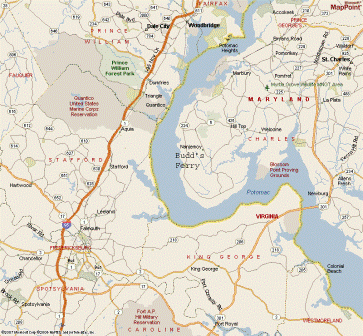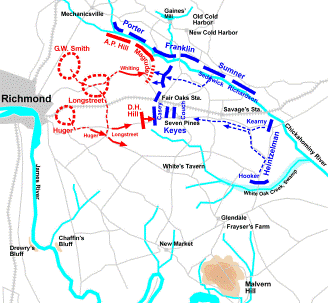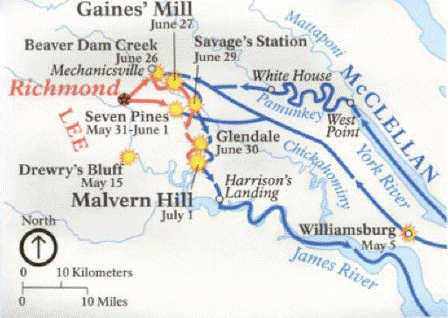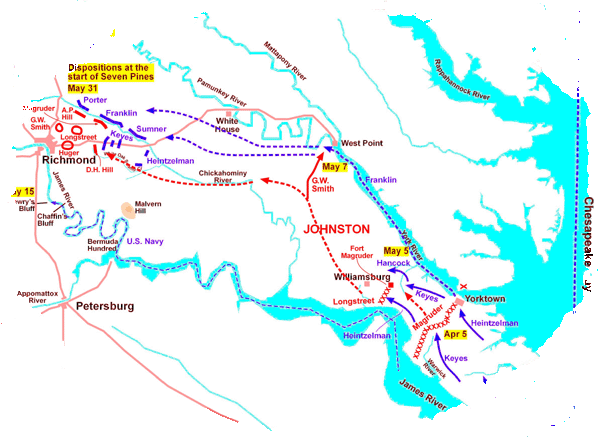Hawley Ancestors Who Served In The Civil War
Given the very high percentage of eligible men who served in the Civil War, it is not surprising that our family was well represented in that conflict. Lewis Hawley, George Gregory and George Gregory's brother-in-law, John Pinney, all enlisted for three years in early May of 1861. They served in the 71st New York Volunteers, also known as the Second Excelsior. Lewis Hawley's brother-in-law, Charles O. Vernold, served with another Excelsior regiment, the 72nd Volunteers, and was killed in fighting at Bristoe Station, Virginia in 1862. Lewis Hawley was wounded and captured just days later, during the 2nd Battle of Manassas.
Lewis Hawley's brother, T. Johnson Hawley served for three years with the 144th Infantry Regiment and mustered out as First Sergeant of his company. Andrew Thomson, George Gregory's father-in-law, enlisted in late August of 1864. He was assigned initially to Company I of the 144th New York Volunteers, but transferred almost immediately to Company G, 1st New York Engineers.
The Seventy-First New York Volunteers, also known as the 2nd Excelsior Regiment, were recruited by Daniel E. Sickles and mustered into United States service at Camp Scott, on Staten Island, between June 20th and July 18th of 1861. Two of my great grandfathers, George W. Gregory and Lewis M. Hawley, were assigned to Company I of the 71st Regiment. Lewis enlisted at Great Valley on May 2, 1861 and George enlisted at Colchester on May 1, 1861. Lewis Hawley was promoted to Sergeant and fought in all of the 71st Regiment's battles until he was severely wounded at Gettysburg on 2 July 1864. Deployed with Sickles' Corps along the Emmitsburg Road, Lewis suffered wounds to both legs late in the afternoon of 2 July and lay unattended on the battlefield for more than two days. Battlefield surgeons amputated his left leg on July 5th. He and his Corps Commander, Major General Dan Sickles, both lost a leg in that battle, and Lewis was subsequently known as 'Peg Leg Lew'. He had previously been wounded and captured at the 2nd battle of Manassas on August 29, 1862. He was paroled soon after that battle and rejoined the 71st in time for the battle at Fredericksburg. George Gregory served with the 71st Regiment in all its battles and was wounded during the initial assault at Petersburg on 18 June 1864. He was discharged soon after at the end of his three year enlistment. [1] What follows is a summary of the 71st New York Volunteers service.
71st New York Volunteers Civil War Campaigns

The 71st Regiment spent the Fall and Winter of 1861-62 on guard duty near Budd's Ferry, opposite Quantico, Virginia on the Potomac River. [2] That time was well spent learning what it takes to be a soldier and preparing for the more than two years of arduous fighting and marching that lay ahead.
The Peninsula Campaign
March - July 1862
The 71st Joins The Battle For Yorktown
On April 9, 1862 the Seventy First, now part of the Second Brigade of the Second Division, Third Corps of the Army of the Potomac, was moved by river transport to Fort Monroe on the Virginia Peninsula. The first battle of the Peninsula Campaign, the Battle of Yorktown, had already begun and the Regiment was soon in the thick of it. Brigadier General John B Magruder, the Confederate commander at Yorktown, deceived McClellan into thinking he faced a far larger force and delayed the Union advance to Richmond by more than a month. After Yorktown, the 71st rejoined the Excelsior Brigade as the Army of the Potomac continued its march to Richmond. By the end of May, 1862 they were camped on the Chickahominy River at Bottom's Bridge, about four miles east of the current Richmond Airport. The Battle of Seven Pines, also called Fair Oaks, was about to begin.
May 31 June 1, 1862

Battle of Seven Pines - Fair Oaks
May 31 - June 1, 1862
By the end of May, the Army of the Potomac had moved to within twelve miles of Richmond. McClellan divided his army, placing two corps south of the Chickahominy River and three to the north. General Joseph E. Johnston sought to take advantage of the divided Union army by having two thirds of his army attack Major General Samuel P. Heintzelman's III Corps and Major General Erasmus Darwin Keyes' IV Corps south of the Chickahominy. The plan called for four different Confederate columns to converge on the Union troops via three roads, and the intricate battle plan, issued verbally, fell apart almost immediately on the morning of May 31. Major General D. H. Hill opened the battle at 1:00 pm when his unsupported brigades struck Keyes' positions at Seven Pines. Longstreet finally supported Hills attack with one brigade, and the Federals withdrew when the fighting ended around 6:00 pm.
Meanwhile, Whiting charged the Union positions at Fair Oaks around 4:00 pm. Major General Edwin Sumner pushed reinforcements across the Chickahominy and these troops blunted the Confederate attack. Johnston, riding along his lines striving to achieve victory in the twilight, was seriously wounded which led to Robert E. Lee taking command of the Confederate Army.
Lee ended the engagement by ordering a withdrawal. McClellan, even though a part of his army was nearly destroyed but for poor Confederate organization, won a tactical victory. The Federals suffered 5,031 casualties and the Confederates 6,134'.[4]
The Excelsior Brigade was engaged near Fair Oaks on the first of June, to the south of the Williamsburg Road. The 71st met a determined Confederate force there and after one or two volleys, made a bayonet charge which succeeded in driving the enemy from the field.[5]

The Seven Days' Battles
The 71st Regiment spent the rest of June, 1862 in the area of Seven Pines engaged in almost daily skirmishes with the Confederates. This difficult month culminated in what is known as The Seven Days' Battles from June 25 to July 1, 1862. On June 24th, the Excelsior Brigade was deployed across the Williamsburg Road immediately behind the forward line of pickets preparatory to a major advance on Richmond. The 71st was positioned just north of the Williamsburg Road. The attack began at 8AM of June 25th, and after a heavy day of fighting the objective was reached. On June 26, Lee's Army of Northern Virginia counter attacked the Union right flank at Mechanicsville, suffering heavy losses in attacks against strong Union positions on Beaver Dam Creek. But the threat to the Union base on the York River prompted McClellan to begin a series of sidestepping withdrawals and holding actions. These climaxed the Peninsula Campaign at Malvern Hill and enabled the Union army to avoid disaster by circling east of Richmond to the security of Federal gunboats on the James River at Harrison's Landing.[6]
Battle of 2nd Manassas (Bull Run)
Lee recognized that if he remained in defensive positions around Richmond, his Army would eventually be caught between the Army of the Potomac threatening Richmond from the south, and Pope's Army of Virginia to the north; so he sent Stonewall Jackson to threaten Pope's rear. This maneuver achieved the desired result, and on August 3rd, McClellan was ordered to withdraw from the Peninsula and move the Army of the Potomac to Aquia Creek in support of Pope. The 71st left Harrison's Landing on August 15th, marched to Yorktown via Jones Bridge and Diascund Bridge, and embarked on the 20th for Alexandria. It arrived at Warrenton Junction on the 26th, just in time for the 2nd Battle of Manassas.... read the whole story.
The Excelsior Brigade, and the rest of Hooker's Division, met Ewell's division near Bristoe Station on the afternoon of Aug 27th, and after a hard fight routed them at a cost of 307 men killed, wounded or missing. With Hooker's Division nearly out of ammunition, Pope ordered General Porter to move forward in a night march and reinforce Hooker at Bristoe Station. Porter failed to execute the order, claiming exhaustion on the part of his men, but the Union Army's movements prompted Stonewall Jackson to withdraw through Centreville, a movement that spared the Union Army the consequences of Porter's disobedience. [7]
Pope sent his forces in pursuit of Jackson, and on the 29th, Hooker's Division, including the 71st Regiment, engaged Jackson's retreating force near Groveton. Lewis Hawley was wounded and taken prisoner by the Confederates during this engagement. Additional engagements occurred on the 30th at Bull Run and on September 1st at Chantilly.
Hooker's 2nd Division numbered fully 10,000 men at Yorktown, and received a reinforcement of about 3,000 more; after Manassas, it drew rations at Fairfax Station for only 2,400 men. ... read more on 2nd Manassas.
The 71st and the rest of the 3rd Corps was ordered into the defenses of Washington, near Alexandria, to rest and recruit, remaining there during the Maryland campaign, and hence was not present at Antietam. On November 1, 1862 the 71st broke camp and marched for Manassas Junction, where it remained for some three weeks, then marched with the rest of the army to the Rappahannock in front of Fredericksburg. The regiment crossed the Rappahannock on December 13th, but avoided the worst of the Battle of Fredericksburg; losing only 16 killed, wounded or missing. After the disaster at Fredericksburg, Hooker assumed command of the Army of the Potomac, and he spent the rest of the winter of 1862-63 preparing the Army for a new offensive to be launched in the spring of 1863.... read more on the battle of Fredericksburg.
Chancellorsville
On May 1, 1863, the 71st crossed the Unites States Ford, on the Rappahannock, to attack Lee's Army at Chancellorsville. Held in reserve until the evening of May 2nd, the 71st and the rest of Berry's 2nd Division were thrown into the breach to halt Stonewall Jackson's advance after the Union Army's 11th Corps collapsed. They turned the tide and forced the confederates to fall back for the night, a night when Stonewall Jackson would be mortally wounded by his own troops during an exchange with the Excelsior Brigade's 73rd Regiment, posted to the left of the 71st near the Plank Road.
On May 3rd, the Confederates renewed their attack and soon forced the 71st to withdraw. The brigade reformed to support the artillery reserve, but BGen Revere, then in command, marched the brigade to the rear.It was the only instance in the brigade's history of being marched from the field while under fire. As soon as this was discovered, BGen Revere was relieved, and Colonel Farnum of the 70th Regiment was placed in command. The brigade was then marched back to the battleground, and remained at the front until the army re-crossed the Rappahannock. It lost 250 killed, wounded or missing in this battle.
Gettysburg
Having frustrated Hooker at Chancellorsville, Lee decided to test the Union's will by invading the North. Hooker followed as Lee moved through Maryland and into Pennsylvania. The stage was set for the Battle of Gettysburg, where MGen Daniel Sickles, now 3rd Corps Commander, and Lewis Hawley, our ancestor, would both lose a leg. In one of the more controversial decisions at Gettysburg, Sickles deployed the 71st, and the rest of the 3rd Corps well forward of the rest of the Army, along the Emmittsburg Road, with both flanks 'in the air'. On July 2nd, the 71st and the rest of the 3rd Corps, was forced to fall back from its untenable position on the Emmittsburg Road, leaving Lewis M. Hawley to lie on the field of battle with his wounded leg for three days. Of the 333 men who entered this fight with the 71st, 91 were killed, wounded or missing in action. Lewis Hawley's leg was amputated on July 5th by F. Prentice of the 73rd Regiment.
Wapping Heights
After a delay which most historians consider excessive, the Union Army started in pursuit of the withdrawing confederates, and on the afternoon of July 23d the 71st, now missing Lewis Hawley, but with George Gregory still assigned, overtook the enemy at Manassas Gap. The confederates had established a strong defensive position on Wapping Heights, and General Meade determined to dislodge this force, push through the gap, and compel Lee's army to give battle. The Excelsior Brigade was selected for the initial assault and succeeded in driving the confederates from their defenses. BGen Spinola, commanding the brigade, fell seriously wounded, and Col Farnum took command once more.The brigade lost 74 killed and wounded in this action.
Wilderness Campaign
After the battle at Wapping Heights, the Excelsior Brigade was bivouacked near Brandy station, and was not committed to battle again until November 27th, at Locust Grove, during the Mine Run campaign, where the brigade lost 45 killed and wounded. During the winter of 1863 and 1864 the Union Army, now under Grant, was reorganized, and when the Battle of the Wilderness began on May 5th, the Excelsior Brigade, now commanded by Col William Brewster, was assigned to the 4th Division, commanded by BGen Gershom Mott, under the 2nd Corps, commanded by MGen Winfield Hancock. The Brigade was heavily engaged for two days near Todd's Tavern, losing 140 killed, wounded or missing.
Spotsylvania Court House to Petersburg
Having lost nearly 20% of his army at the Wilderness, Grant withdrew toward Spotsylvania Court House, which as fate would have it was Lee's destination as well. Lead elements of the two armies collided on Spindle Farm along the Brock Road on May 8th, and Hancock's 2nd Corps joined the fight on May 9th. The two armies battled for two weeks to an inconclusive but costly draw, with the Excelsior Brigade involved in some of the fiercest fighting of the war, including at the Bloody Angle, where the brigade lost 148 killed, wounded or missing.
The two armies disengaged on May 20/21, but there was no rest in sight for the Excelsior Brigade. Now the Fourth Brigade, 3rd Division, 2nd Corps; they were engaged at North Anna on May 23d, on the 30th at Totopotomoy and on the morning of June 3d, participated in the assault at Cold Harbor. Their losses totaled 76 killed, wounded or missing in these actions.
Grant's next move was to attack Petersburg, and the Excelsior Brigade fought its last battle, assaulting the confederate defenses from June 16-18 at a cost of 86 killed, wounded or missing. Among those was George Gregory, wounded during the final attack on Petersburg's defenses on June 18, 1864. Petersburg remained under siege until Lee's surrender on April 12, 1865.
[1] Army Operational Report - Series I - Volume 5 [S#5] - #1 Report of MGen George B. McClellan
[2] Military service records maintained at the New York State archives
[3] Army Operational Report - Series I - Volume XI/1 [S#12] - #1 Report of BGen Samuel P. Heintzelman
[4] Wiki Peninsula Campaign
[5] Army Operational Report - Series I - Volume XI/1 [S#12] - #37 Report of BGen Samuel P. Heintzelman
[6] National Park Service.gov
[7] O.R.-- SERIES I--VOLUME XII/2 [S# 16], No. 2.--Reports of Maj. Gen. John Pope
